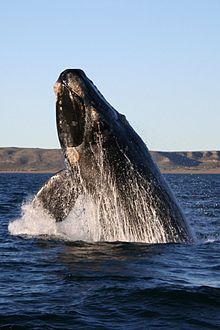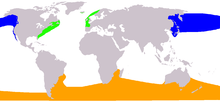
Back حوت حقيقي Arabic حوت حقيقى ARZ Megol (Eubalaena) AVK Южни китове Bulgarian Balena franca Catalan Eubalaena CEB Eubalaena German Veraj balenoj Esperanto Eubalaena Spanish Eubalaena Basque
| Right whales[2] Temporal range: Miocene–recent
| |
|---|---|

| |
| Southern right whale breaching | |

| |
| Size compared to an average human | |
| Scientific classification | |
| Domain: | Eukaryota |
| Kingdom: | Animalia |
| Phylum: | Chordata |
| Class: | Mammalia |
| Order: | Artiodactyla |
| Infraorder: | Cetacea |
| Family: | Balaenidae |
| Genus: | Eubalaena Gray, 1864 |
| Type species | |
| Balaena australis [2] Desmoulins, 1822
| |
| Species | |
| |

| |
| Range map of Eubalaena species: E. glacialis[5] E. australis[3] E. japonica[6]
| |
| Synonyms[8] | |
| |
Right whales are three species of large baleen whales of the genus Eubalaena: the North Atlantic right whale (E. glacialis), the North Pacific right whale (E. japonica) and the Southern right whale (E. australis). They are classified in the family Balaenidae with the bowhead whale. Right whales have rotund bodies with arching rostrums, V-shaped blowholes and dark gray or black skin. The most distinguishing feature of a right whale is the rough patches of skin on its head, which appear white due to parasitism by whale lice. Right whales are typically 13–17 m (43–56 ft) long and weigh up to 100 short tons (91 t; 89 long tons) or more.
All three species are migratory, moving seasonally to feed or give birth. The warm equatorial waters form a barrier that isolates the northern and southern species from one another although the southern species, at least, has been known to cross the equator. In the Northern Hemisphere, right whales tend to avoid open waters and stay close to peninsulas and bays and on continental shelves, as these areas offer greater shelter and an abundance of their preferred foods. In the Southern Hemisphere, right whales feed far offshore in summer, but a large portion of the population occur in near-shore waters in winter. Right whales feed mainly on copepods but also consume krill and pteropods. They may forage the surface, underwater or even the ocean bottom. During courtship, males gather into large groups to compete for a single female, suggesting that sperm competition is an important factor in mating behavior. Gestation tends to last a year, and calves are weaned at eight months old.
Right whales were a preferred target for whalers because of their docile nature, their slow surface-skimming feeding behaviors, their tendency to stay close to the coast, and their high blubber content (which makes them float when they are killed, and which produced high yields of whale oil). Although the whales no longer face pressure from commercial whaling, humans remain by far the greatest threat to these species: the two leading causes of death are being struck by ships and entanglement in fishing gear. Today, the North Atlantic and North Pacific right whales are among the most endangered whales in the world.
- ^ "Fossilworks".
- ^ a b Mead, J. G.; Brownell, R. L. Jr. (2005). "Order Cetacea". In Wilson, D. E.; Reeder, D. M. (eds.). Mammal Species of the World: A Taxonomic and Geographic Reference (3rd ed.). Johns Hopkins University Press. pp. 723–743. ISBN 978-0-8018-8221-0. OCLC 62265494.
- ^ a b Cite error: The named reference
iucn-australiswas invoked but never defined (see the help page). - ^ Bisconti M, Lambert O, Bosselaers M. (2017) Revision of “Balaena” belgica reveals a new right whale species, the possible ancestry of the northern right whale, Eubalaena glacialis, and the ages of divergence for the living right whale species. PeerJ 5:e3464 https://doi.org/10.7717/peerj.3464
- ^ a b Cooke, J.G. (2020). "Eubalaena glacialis". IUCN Red List of Threatened Species. 2020: e.T41712A178589687. doi:10.2305/IUCN.UK.2020-2.RLTS.T41712A178589687.en. Retrieved November 12, 2021.
- ^ a b Cooke, J.G.; Clapham, P.J. (2018). "Eubalaena japonica". IUCN Red List of Threatened Species. 2018: e.T41711A50380694. doi:10.2305/IUCN.UK.2018-1.RLTS.T41711A50380694.en. Retrieved November 12, 2021.
- ^ Kimura, T.; Narita, K. (2007). "A new species of Eubalaena (Cetacea: Mysticeti: Balaenidae) from the Gonda Formation (latest Miocene-early Pliocene) of Japan". Bulletin of the Gunma Museum of Natural History. 11: 15–27.
- ^ Perrin, W. F. (2012). "Eubalaena Gray, 1864". World Cetacea Database. Retrieved September 29, 2012.
© MMXXIII Rich X Search. We shall prevail. All rights reserved. Rich X Search